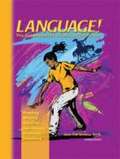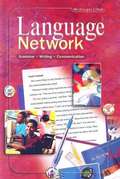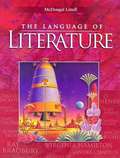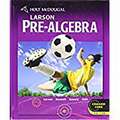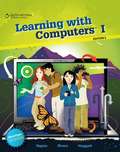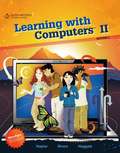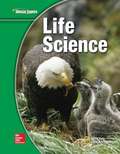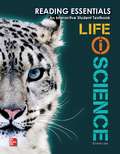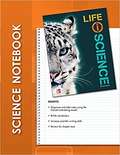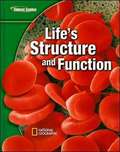- Table View
- List View
More NIMAC books are available at www.nimac.us. If you find your title in the NIMAC and not in Bookshare then please contact us to request it.
Language! The Comprehensive Literacy Curriculum [Book F]
by Jane Fell Greene Nancy Chapel EberhardtLANGUAGE! (4th Edition) Student Text, Book F
The Language of Literature
by Arthur N. Applebee Andrea B. Bermúdez Sheridan BlauNIMAC-sourced textbook
Learning with ComputersTM I
by H. Albert Napier Ollie N. Rivers Jack P. HoggattThe new second edition LEARNING WITH COMPUTERS I (Level Green, Grade 7) is a revision of the first edition project-based text to cover Microsoft Office 2007 and 2010. There is also a companion text, LEARNING WITH COMPUTERS II (Level Orange, Grade 8). This series for middle school students delivers a strong foundation in keyboarding and computer applications. In this project based text, students are introduced to the Explorers Club where four young members of the club - Luis, Ray, Julie, and Lin - guide students on Microsoft Office explorations. Along the way, each student keeps a personal journal about their explorations. The text offers multiple opportunities to reinforce and maintain basic keyboarding, word processing, spreadsheet, presentation, database, graphics, and Internet skills. Students are also introduced to new grade-level appropriate computer skills based on the National Educational Technology Standards (NETS). Additionally, the text emphasizes research, reading, and writing activities relevant to social studies, science, math, and language arts curriculum. The text for use with Windows applications, is divided into 4 units; Word Processing, Spreadsheets, Presentations (Graphics, Multimedia, and Integration) and Databases. Each unit contains multiple projects for a total of 18 projects per text, plus an introductory project. Each project focuses on a group of grade-level appropriate objectives for particular computer applications. Several hands-on activities within each project are designed around these objectives. This one-semester text can be used as a stand alone or in conjunction with South-Western's MicroType keyboarding software. MicroType is an engaging, easy-to-use program that teaches new-key learning and skill building. Features include 3-D animations, videos, and fun interactive games.
Learning with ComputersTM II
by H. Albert Napier Ollie N. Rivers Jack P. HoggattThe new second edition LEARNING WITH COMPUTERS II (Level Orange, Grade 8) is a revision of the first edition preject-based text to cover Microsoft Office 2007 and 2010. There is also a companion text, LEARNING WITH COMPUTERS I (Level Green, Grade 7). This series for middle school students delivers a strong foundation in keyboarding and computer applications. In this project based text, students are introduced to the Explorers Club where four young members of the club - Luis, Ray, Julie, and Lin - guide students on virtual explorations. Along the way, each student keeps a personal journal about their explorations. The text offers multiple opportunities to reinforce and maintain basic keyboarding, word processing, spreadsheet, presentation, database, graphics, and Internet skills. Students are also introduced to new grade-level appropriate computer skills based on the National Educational Technology Standards (NETS). Additionally, the text emphasizes research, reading, and writing activities relevant to social studies, science, math, and language arts curricula. The text for use with Windows applications, is divided into 4 units; Word Processing, Spreadsheets, Presentations (Graphics, Multimedia, and Integration) and Databases. Each unit contains multiple projects (totaling 18 projects per text), plus an introductory project. Each project focuses on a group of grade-level appropriate objectives for particular computer applications. Several hands-on activities within each project are designed around these objectives. This one-semester text can be used as a stand alone text or in conjunction with South-Western's MicroType keyboarding software. MicroType is an engaging, easy-to-use program that teaches new-key learning and skill building. Features include 3-D animations, videos, and fun interactive games.
Level H, Module 2, Integers and Number Theory
by Voyager Expanded Learning L. P.NIMAC-sourced textbook
Level H, Module 5, Geometry and Measurement
by Voyager Expanded Learning L. P.NIMAC-sourced textbook
Level H, Module 7, Ratio, Proportion, and Percent
by Voyager Expanded Learning L. P.NIMAC-sourced textbook
Level H, Module 8, Data, Probability, and Statistics
by Voyager Expanded Learning L. P.NIMAC-sourced textbook
Life Science
by Alton Biggs Lucy Daniel Edward Ortleb Peter Rillero Dinah ZikeWith a broad array of innovative print and technology resources,GlencoeLife Sciencehelps teachers differentiate and accommodate all learners. The range of labs, content area reading, discussion strategies, note-taking tools, and activities provides students with multiple experiences of each Science Benchmark. They give teachers flexibility and the ability to monitor student progress through ongoing assessment.
Life Science 2: What Is Going On Inside Me? (IQWST)
by Joseph Krajcik Brian ReiserNIMAC-sourced textbook
Life Skills for the 21st Century: Building a Foundation for Success
by Suzanne Weixel Faithe WempenResponsible living skills presented in an engaging and bold style. Today's world asks students to balance a wide range of responsibilities -- from succeeding in school, to building personal relationships, to beginning a career, to giving back to their community. Life Skills for the 21st Century: Building a Foundation for Success gives students the tools and confidence to think critically about the choices they make, take control of their lives, and ultimately achieve their goals. Designed in a unique magazine format that speaks to today's student and written to meet state FACS standards, this engaging, contemporary, user-friendly first edition text focuses on shaping and sustaining the five critical and interdependent areas of responsible living: family, peers, school, work, and community.
Life's Structure and Function
by Glencoe Mcgraw-HillDiscover the Flexibility to Teach Science Your Way!. "Glencoe Science: Life's Structure and Function," a module in the Glencoe Science 15 book series, provides students with accurate and comprehensive coverage of middle school National Science Education Standards. Concepts are explained in a clear, concise manner, and are integrated with a wide range of hands-on experiences, critical thinking opportunities, real-world applications, and connections to other sciences and to non-science areas of the curriculum. Co-authored by National Geographic, unparalleled graphics reinforce key concepts. A broad array of print and technology resources help differentiate and accommodate all learners. The modular approach allows you to mix and match books to meet your specific curriculum needs..

